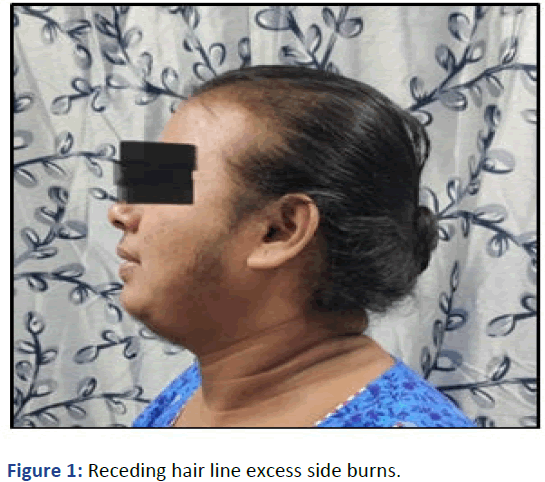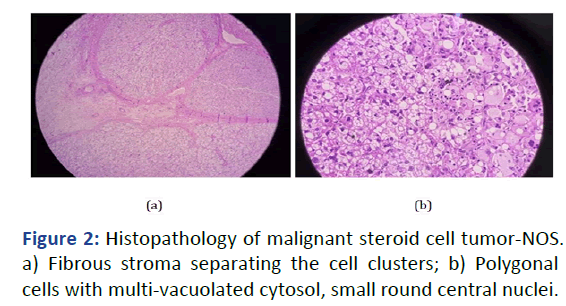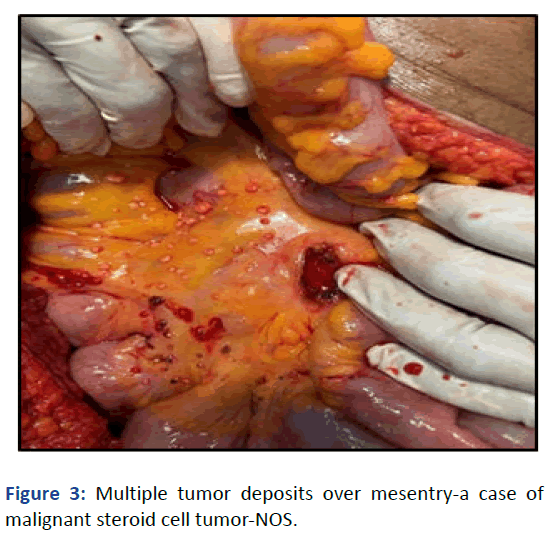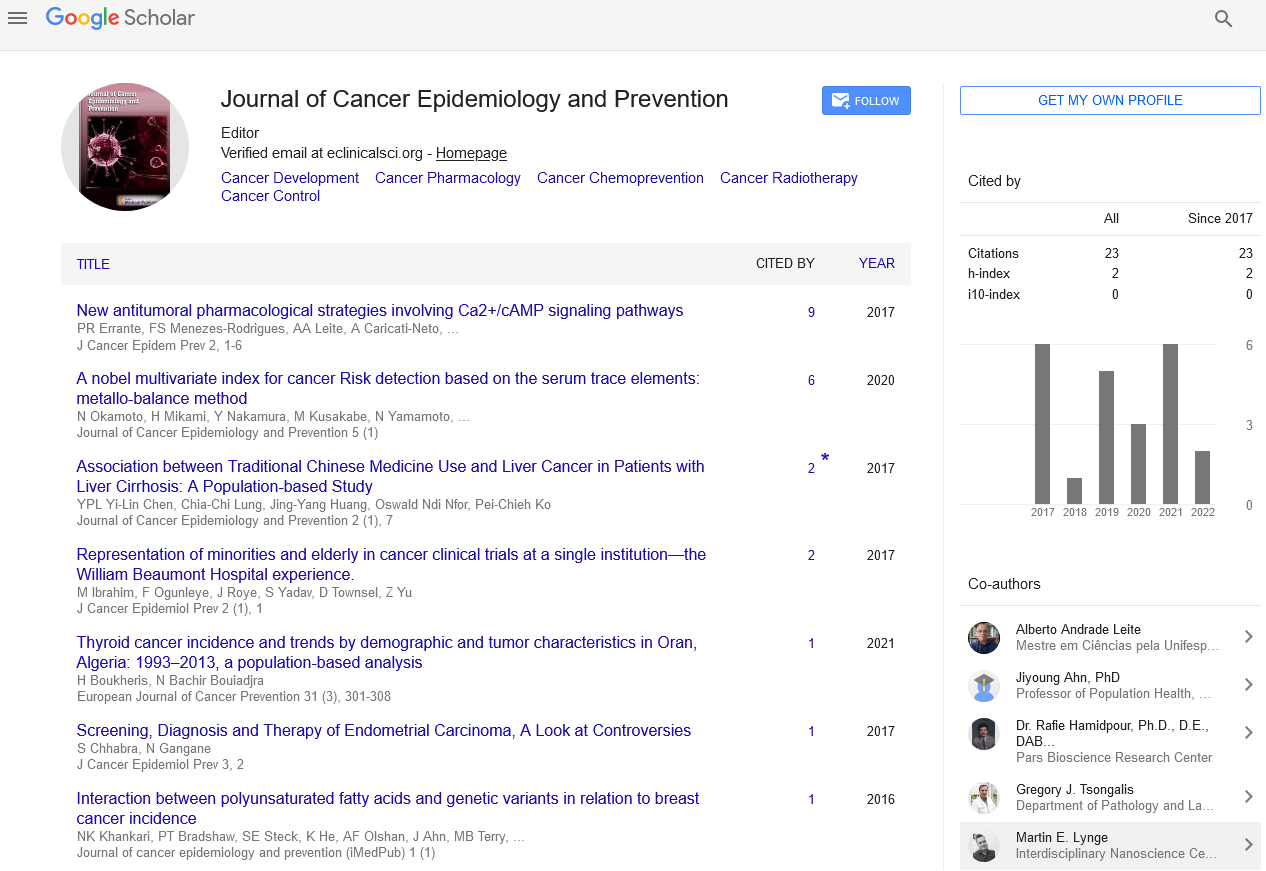Case Report - (2023) Volume 8, Issue 2
Steroid Cell Tumor-Not Otherwise Specified: A Not So Rare Tumor of Ovary
Sahana Punneshetty1*,
Anitha Thomas1,
Sherin Daniel2 and
Ashish Singh3
1Department of Gynaecology Oncology, Christian Medical College, Vellore, India
2Department of Pathology, Christian Medical College, Vellore, India
3Department of Medical Oncology, Christian Medical College, Vellore, India
*Correspondence:
Sahana Punneshetty, Department of Gynaecology Oncology, Christian Medical College, Vellore,
India,
Email:
Received: 01-Jun-2023, Manuscript No. PJCEP-23-17714;
Editor assigned: 05-Jun-2023, Pre QC No. PJCEP-23-17714 (PQ);
Reviewed: 19-Jun-2023, QC No. PJCEP-23-17714;
Revised: 13-Sep-2023, Manuscript No. PJCEP-23-17714 (R);
Published:
11-Oct-2023, DOI: 10.36648/IPJCEP.23.08.016
Abstract
Steroid cell tumor-not otherwise specified accounts for sixty percent of the rare steroid cell tumors.
These tumors are presumed to be of ovarian stromal cell origin. They are typically benign with one
third of them exhibiting malignant behaviour. Androgenic manifestations are common and are the
predominant complaints among these patients. They are slow growing in nature and are known for
late recurrences. Surgery is the gold standard treatment for both benign and malignant variants. Early
stages have good prognosis and good survival, inclusive of fertility sparing surgeries. There is no
standard of treatment with respect to advanced stages management and is usually customized to
patients. However, complete cytoreductive surgery plays a curative role in these cases similar to
epithelial ovarian tumors and is the initial step. Adjuvant therapy has evolved over time and is not
limited to taxane/platinum based chemotherapy. Hormonal therapy has shown promising results in
recurrent cases and needs further validation.
Keywords
Steroid cell tumor NOS; Surgery; Adjuvant therapy; Cushing’s syndrome; Hormonal
therapy
Introduction
Steroid cell tumor are rare ovarian parenchymal tumors and
account for 0.1% of sex-cord stromal tumors. Earlier known as
lipoid cell tumor, secondary to the appearance of their cell
cytosol, is obsolete now. The WHO classifies them as pure
stromal tumors arising from mesenchymal cells of ovarian
stroma. These tumors have been sub-divided into stromal
luteomas, leydig cell tumor and steroid cell tumor-Not
Otherwise Specified (NOS). Half of these patients present with
androgenic manifestations, 10% estrogenic and occasionally with features of cushing’s syndrome and progestational
changes. Symptoms vary from precocious puberty,
amenorrhea, hirsutism to virilization. Around one third of
these steroid cell tumors exhibit malignant behavior [1,2].
Case Presentation
Stromal luteomas account for 20%-25% and are benign in
nature. Typically seen in post-menopausal women, manifest
with abnormal uterine bleeding and virilization symptoms.
Stromal hyperthecosis co-exists in 90% of cases. Treatment is surgical removal of the ovaries. Leydig cell tumor is a benign
entity, predominantly located in the ovarium hilum [3]. The
average age of presentation is 58 years and typically present
with androgenic endocrine manifestations. These tumors are
usually small (<2 cm) and have solid, well circumscribed
appearances on gross examination. Histologically, they
typically have well circumscribed polyhedral cells with
eosinophilic cytosol with lipochrome pigments. Reinke crystal
are characteristic of these tumors. Mitoses are rare and
immuno-histochemistry shows positive for inhibin, melan A
and calretinin [4].
Steroid cell tumor not otherwise specified: These tumors lack
definitive tumor characteristic and account for 56%-60% of
steroid cell tumors. Around 25%-43% of them are malignant
in nature unlike the rest two entities [5]. The average age of
presentation is 43 years. Patients usually present with
symptoms/signs of androgen excess and in our practice, this
has been the most common presentation of these patients
(Figure 1).

Figure 1: Receding hair line excess side burns.
The symptoms vary from hirsutism, receeding hair line, voice
hoarseness and virilization (56%-77%). Other symptoms
include sub-acute pelvic pain, abdominal distension,
menstrual irregularities. Rarely they do present with
abdominal distension, especially in advanced stages
attributing to ascites. Bony metastases has been documented.
Tumor markers serum inhibin and anti mullerian hormone,
though non specific can be used as a surrogate marker for
diagnosis and follow up. There is also elevation of serum
testosterone and dehydro-epiandrosterone [6,7].
Results and Discussion
Histopathological examination is crucial for diagnosis. Gross
appearances reveal solid-cystic tumors with haemorrhage and
necrosis varying from yellow to blackish areas. Histologically,
these tumors exhibit expansile diffuse growth of large
polygonal cells. The cells have abundant cytosol that range
from eosinophilic (lipid poor) to pale vacuolated cells (lipid rich) [8,9]. Stroma ranges from scant to prominent fibrous
bands. The nuclei are round with prominent nucleolus (Figure
2).

Figure 2: Histopathology of malignant steroid cell tumor-NOS.
a) Fibrous stroma separating the cell clusters; b) Polygonal
cells with multi-vacuolated cytosol, small round central nuclei.
Mitotic activity, necrosis are typically indicators of worse
histology. Reinke crystals are absent. Hayes and Scully
identified five pathological factors predictive of malignancytwo
or more mitoses per high power fields (92% malignant); a
tumor diameter of >7 cm (78% malignant); necrosis (86%
malignant); haemorrhage (77% malignant) and grade 2 or 3
nuclear atypia (64% malignant) [10]. Immunohistochemistry
shows positive for calretinin, inhibin and melan A and usually
negative for FOXL2.
The staging for non-epithelial ovarian tumors is adopted from
International Federation of Gynecology and Obstetrics (FIGO)
of epithelial ovarian cancers. Conservative surgery can be
offered to young women for ovary confined disease. Uterine
endometrial curettage must be advocated before fertility
preservation surgery, as they are hormone secreting tumors
[11,12]. Total abdominal hysterectomy with bilateral salpingooophorectomy
with complete staging is the standard of
choice. Routine lymphadenectomy for staging purpose is not
advocated, as nodal metastasis is very low. Complete
cytoreduction surgery should be advocated for advance cases
with tumor dissemination (Figure 3).

Figure 3: Multiple tumor deposits over mesentry-a case of
malignant steroid cell tumor-NOS.
Management of advanced cases is challenging due to chemoresistance
and scarcity of trials. Surgical cytoreduction is the
primary treatment for stage II-stage IV followed by adjuvant
chemotherapy. Metastases to rare sites like bone, lung, liver
and peritoneum have been documented [13]. Peritoneal
metastasis are seen in around twenty percent of the cases.
Platinum based chemotherapy has remained the first line of
choice for sex cord stromal tumors with bleomycin, etoposide,
cisplatin as the most preferred regimen. The efficacy of BEP in
sex cord stromal tumor is limited, unlike germ cell tumors and
also bleomycin comes with potential side effects, especially
pulmonary fibrosis and secondary malignancy risk with
etoposide. The choice of chemotherapy is not clear due to
paucity of trials in these tumors and few recommended
options include bleomycin, etoposide, cisplatin; carboplatin/
paclitaxel; cyclophosphamide/doxorubicin [14].
The GOG 264, phase II trial randomly assigned women with
newly diagnosed and recurrent chemo naive ovarian sex cordstromal
tumors to primary therapy with carboplatin and
paclitaxel versus cisplatin, etoposide and bleomycin. They
overall recruited 63 patients as study closed due to futility
and difficult accrual. Further results on progression free
survival is pending. There is potential role for use of targeted
therapies and are underway. The ALIENOR trial showed better
response rate with addition of bevacizumab among recurrent
granulosa cell tumor. Bevacizumab has shown an overall
response rate of 17% with stable disease in 78% in relapsed
sex cord stromal tumors. Data on efficacy of other targeted
agents is limited due to less cases and limited clinical trials
[15]. Sex cord stromal tumors, unlike germ cell tumors, are
not characterized by widespread genomic instability, but do
have chromosomal abnormalities. Multi-kinase agent
pazopanib has shown response in recurrent granulosa cell
tumors. Hormonal agents like gonadotrophin releasing
hormone analogues have shown promising results by inducing
cellular apotosis. Their role has been evaluated in recurrent
steroid cell tumor cases with remarkable responses in
multiple studies. With the analogues, the hormonal assays
typically show measurable reduction in their values and
patients have symptomatic relief. The symptoms however
recur with stoppage of these analogues and hence the need
to administer for long duration.
Conclusion
Steroid cell tumors-NOS are not so rare tumors and advanced
malignant steroid cell tumor-NOS can be wearisome to treat.
Complete cytoreduction is the key prognostic factor as seen
with epithelial ovarian tumors. Androgenic symptoms take
time to revert and require post-operative hormonal assay
monitoring. Adjuvant chemotherapy is required for stage II-IV
patients and platinum based therapy is the preferred first line
regime. Management of recurrent cases have to be
individualized and options range from taxane/platinum
combinations to GnRH analogues to targeted therapies.
References
- Monteagudo A, Heller D, Husami N, Levine RU, McCaffrey R, et al. (1997) Ovarian steroid cell tumors: Sonographic characteristics. Ultrasound Obstet Gynecol. 10(4):282-288.
[Crossref] [Google Scholar] [PubMed]
- Cree IA, White VA, Indave BI, Lokuhetty D (2020) Revising the WHO classification: Female genital tract tumours. Histopathology. 76(1):151-156.
[Crossref] [Google Scholar] [PubMed]
- Sternberg WH, Roth LM (1973) Ovarian stromal tumors containing leydig cells. I. Stromal‐leydig cell tumor and non‐neoplastic transformation of ovarian stroma to Leydig cells. Cancer. 32(4):940-951.
[Crossref] [Google Scholar] [PubMed]
- Paraskevas M, Scully RE (1989) Hilus cell tumor of the ovary: A clinicopathological analysis of 12 Reinke crystal-positive and nine crystal-negative casesint J Gynecol Pathol. 8(4):299-310.
[Google Scholar] [PubMed]
- Outwater EK, Wagner BJ, Mannion C, McLarney JK, Kim B (1998) Sex cord-stromal and steroid cell tumors of the ovary. Radiographics. 18(6):1523-1546.
[Crossref] [Google Scholar] [PubMed]
- Kim YT, Kim SW, Yoon BS, Kim SH, Kim JH, et al. (2007) An ovarian steroid cell tumor causing virilization and massive ascites. Yonsei Med J. 48(1):142-146.
[Crossref] [Google Scholar] [PubMed]
- Li K, Zhu F, Xiong J, Liu F (2014) A rare occurrence of a malignant ovarian steroid cell tumor not otherwise specified: A case report and literature review. Oncol Lett. 8(2):770-774.
[Crossref] [Google Scholar] [PubMed]
- Brown J, Sood AK, Deavers MT, Milojevic L, Gershenson DM (2009) Patterns of metastasis in sex cord-stromal tumors of the ovary: Can routine staging lymphadenectomy be omitted. Gynecol Oncol. 113(1):86-90.
[Crossref] [Google Scholar] [PubMed]
- Daviu C, Blaakaer J, Eriksson AGZ, Herrstedt J, Vandborg, et al. (2022) Nonepithelial ovarian cancer-the current clinical practice in the Nordic countries. Survey from the surgical subcommittee of the Nordic Society of Gynecological Oncology (NSGO). Acta Oncol. 61(8):939-945.
[Crossref] [Google Scholar] [PubMed]
- Homesley HD, Bundy BN, Hurteau JA, Roth LM (1999) Bleomycin, etoposide, and cisplatin combination therapy of ovarian granulosa cell tumors and other stromal malignancies: A Gynecologic Oncology Group study. Gynecol Oncol. 72(2):131-137.
[Crossref] [Google Scholar] [PubMed]
- Schultz KAP, Harris AK, Schneider DT, Young RH, Brown J, et al. (2016) Ovarian sex cord-stromal tumors. J Oncol Pract. 12(10):940-946.
[Crossref] [Google Scholar] [PubMed]
- Llombart-Cussac A, Bermejo B, Villanueva C, Delaloge S, Morales S, et al. (2015) SOLTI NeoPARP: A phase II randomized study of two schedules of iniparib plus paclitaxel versus paclitaxel alone as neoadjuvant therapy in patients with triple-negative breast cancer. Breast Cancer Res Treat. 154:351-357.
[Crossref] [Google Scholar] [PubMed]
- Maoz A, Matsuo K, Ciccone MA, Matsuzaki S, Klar M, et al. (2020) Molecular pathways and targeted therapies for malignant ovarian germ cell tumors and sex cord-stromal tumors: A contemporary review. Cancers. 12(6):1397-1398.
[Crossref] [Google Scholar] [PubMed]
- Studentova H, Volakova J, Spisarova M, Zemankova A, Aiglova K, et al. (2022) Severe tyrosine-kinase inhibitor induced liver injury in metastatic renal cell carcinoma patients: Two case reports assessed for causality using the updated RUCAM and review of the literature. BMC Gastroenterol. 22(1):48-49.
[Crossref] [Google Scholar] [PubMed]
- Nakasone T, Nakamoto T, Matsuzaki A, Nakagami H, Aoki Y. (2019) Direct evidence on the efficacy of GnRH agonist in recurrent steroid cell tumor-not otherwise specified. Gynecol Oncol Rep. 29:73-75.
[Crossref] [Google Scholar] [PubMed]
Citation: Punneshetty S, Thomas A, Daniel S, Singh A (2023) Steroid Cell Tumor-Not Otherwise Specified: A Not So Rare Tumor
of Ovary. J Cancer Epidemiol Prev. 08: 016.
Copyright: © 2023 Punneshetty S, et al. This is an open-access article distributed under the terms of the Creative Commons
Attribution License, which permits unrestricted use, distribution, and reproduction in any medium, provided the original author
and source are credited.




